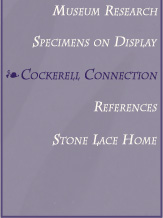One of the founders of the CU Museum, T.D.A. "Theo" Cockerell was an internationally known entomologist, a prolific science writer, and a respected professor at the University of Colorado, Boulder.
Most of the Museum's Florissant fossils were collected by Cockerell and his colleagues while on Museum expeditions in the first decade of the 1900's. Cockerell published many articles that contained the first descriptions of fossil plants and insects.
Considered by many to be the world's expert on bees, Cockerell catalogued more than 900 species of bees in Colorado alone. His interests were not limited to entomology. Cockerell was a well-rounded naturalist in the truest sense of the word. He hunted fossils at the Florissant fossil beds, authored Zoology of Colorado, supported women's rights, and published extensively on science and social issues. Theo Cockerell was a key figure in the introduction of Darwinian theory to American science.
Born in England in 1866, Cockerell first came to the United States in 1887 to cure a mild case of tuberculosis. He served as Director of the Museum of Jamaica and professor at the New Mexico Agricultural College (now New Mexico State University, Las Cruces). Cockerell came to Boulder to stay when his wife was appointed to the teaching staff of Boulder High School. Cockerell finally joined the faculty of the University of Colorado in 1904; he taught entomology and zoology here for 42 years. His many contributions to this campus in both science and the art of teaching are commemorated by the name of a men's dormitory, Cockerell Hall.
To learn more about Theo Cockerell, read The American Cockerell: A Naturalist's Life, 1866-1948 and The Valley of the Second Sons: Letters from Theodore Dru Allison Cockerell, a young English Naturalist writing to his sweetheart and her brother from Westcliff, Wet Mountain Valley, Colorado, 1887-1899, both by William A. Weber, Professor Emeritus, CU Boulder.
|

|